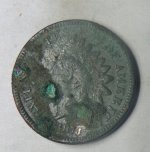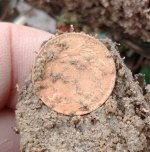Steve Herschbach
Hero Member
Those of you who have followed some of my stuff know I have made trips to Hawaii in the last 20 years, and always I have been trying to find a detector that works well there. The combination of salt water, basalt cobbles and sands, and military grade electrical interference adds up to the toughest detecting conditions I have encountered. Being a prospector at heart it has been obvious to me that ground balancing PI detectors were the answer. Unfortunately, the only real option was the Garrett Infinium. I did do well with the Infinium in Hawaii, but it was very unstable and frankly not very pleasant to use. I yearned for something better and ended up waiting far longer than I thought I would have to. I honestly thought I would see a waterproof White's TDI at some point but it was not to be. Instead, Garrett surprised me with a followup to the Infinium, the new Garrett ATX.
The ATX is being marketed more as a prospecting machine, which kind of overlooks its main strength. It is waterproof to ten feet and built like a tank. I was therefore anxious to get one and get it into the water in Hawaii ASAP and did just that in February. Now, I have to admit to often being disappointed in new detectors these days. Most are just a rehash of something we already have. This is one case where I was actually prepared to be disappointed and just the opposite occurred - the Garrett ATX not only met but exceeded my expectations in Hawaii. Unlike the Infinium, I was able to easily tune it for smooth, clean operation in the worst conditions possible. And despite the competition being vastly increased compared to 20 years ago I was able to pull off my best results ever for a trip to Hawaii, with about 2.5 ounces of gold, silver, and platinum jewelry found.

I used the ATX pretty much the entire time with the 8" round mono coil. I was working in the surf and deeper water with mask and snorkel and found the 8" mono easy to handle in the rough conditions. I could use it to literally mow down sand ridges and get down into pockets in the rock and coral bottom. There were lots of big chunks of loose rock, coral, and plenty of debris from the hurricanes years ago still rolling around on the bottom to work around and the 8" was just great for getting between and around that stuff.
After having EMI problems galore in Hawaii I was surprised when the ATX just did its thing and found a frequency that ran clean of interference. That alone was a huge improvement over the Infinium which despite endless tweaking on my part always had issues with EMI. The combination of the gain control, which the Infinium lacks, and the new ability to ground balance into the salt range combined to make tuning out both the salt water AND the basalt cobbles an easy task. I do not claim my settings were the best possible but they worked for me. I set the pulse delay (discrimination on ATX) to 3 and the sensitivity to 7 which eliminated salt water readings. I may have been able to use less disc and more gain but 3 and 7 was working for me. Then I ground balanced on a basalt cobble underwater. And that was it - clean, stable threshold, just like a VLF on land. Any threshold breaks were targets. Best thing was the ATX retains settings and so after a couple days I just did not mess with it. I turned it on, went detecting, turned it off. I used the same basic settings for most of my trip. I suppose I should have experimented more, but frankly, once it seemed to work well I just got down to the business of detecting. I want to go detecting, not spend my time fiddling with settings.
It was great. I like not having to fuss with the detector. I just put in the hours and recovered targets, and with a PI there are plenty of those. I dug my share of junk plus lots of coins and low value jewelry. But at the end of two weeks I was able to say I had easily found more rings in one trip to Hawaii than ever before and so for me the trip was a resounding success, and all due to the Garrett ATX. Well, it and a lot of hours of hard effort in some pretty stiff surf!
The ATX proved very robust with no concern at all on my part about leakage after a couple days. I would pull batteries and charge every couple days and there was never a drop of water in the compartments. I worked the rod and cams at the end of every outing in the water and had no real issue, though the uppermost cam got a bit stiff from sand trapped internally. I disassembled and cleaned it when I got home. The ability to quickly adjust from super short while on my knees in the shallows to extra long when on my tip toes in deep water was greatly appreciated. And I had to lean hard on the ATX when getting knocked about in the surf with no fear of breakage.
I can't say enough good things about the ATX and how it works for me as a water machine for highly mineralized conditions. There would be less benefit in white sand beaches. Ground balancing PI detectors shine where ground conditions are worst. Red soils and black volcanic sands are where the ATX will really outperform the other water machines out there.
In closing, please do not take this as a sales pitch or even as encouragement to buy an ATX. PI detectors are not for everyone and some people who think the ATX is some kind of magic due to this post will be disappointed. I'm not trying to talk anyone into anything. I just know what works for me and what I like and for me at least my search for my perfect Hawaii detector is over. The Garrett ATX does it for me. I have lots more water hunting planned for the ATX in the future and can't wait to get to it.
The ATX is being marketed more as a prospecting machine, which kind of overlooks its main strength. It is waterproof to ten feet and built like a tank. I was therefore anxious to get one and get it into the water in Hawaii ASAP and did just that in February. Now, I have to admit to often being disappointed in new detectors these days. Most are just a rehash of something we already have. This is one case where I was actually prepared to be disappointed and just the opposite occurred - the Garrett ATX not only met but exceeded my expectations in Hawaii. Unlike the Infinium, I was able to easily tune it for smooth, clean operation in the worst conditions possible. And despite the competition being vastly increased compared to 20 years ago I was able to pull off my best results ever for a trip to Hawaii, with about 2.5 ounces of gold, silver, and platinum jewelry found.

I used the ATX pretty much the entire time with the 8" round mono coil. I was working in the surf and deeper water with mask and snorkel and found the 8" mono easy to handle in the rough conditions. I could use it to literally mow down sand ridges and get down into pockets in the rock and coral bottom. There were lots of big chunks of loose rock, coral, and plenty of debris from the hurricanes years ago still rolling around on the bottom to work around and the 8" was just great for getting between and around that stuff.
After having EMI problems galore in Hawaii I was surprised when the ATX just did its thing and found a frequency that ran clean of interference. That alone was a huge improvement over the Infinium which despite endless tweaking on my part always had issues with EMI. The combination of the gain control, which the Infinium lacks, and the new ability to ground balance into the salt range combined to make tuning out both the salt water AND the basalt cobbles an easy task. I do not claim my settings were the best possible but they worked for me. I set the pulse delay (discrimination on ATX) to 3 and the sensitivity to 7 which eliminated salt water readings. I may have been able to use less disc and more gain but 3 and 7 was working for me. Then I ground balanced on a basalt cobble underwater. And that was it - clean, stable threshold, just like a VLF on land. Any threshold breaks were targets. Best thing was the ATX retains settings and so after a couple days I just did not mess with it. I turned it on, went detecting, turned it off. I used the same basic settings for most of my trip. I suppose I should have experimented more, but frankly, once it seemed to work well I just got down to the business of detecting. I want to go detecting, not spend my time fiddling with settings.
It was great. I like not having to fuss with the detector. I just put in the hours and recovered targets, and with a PI there are plenty of those. I dug my share of junk plus lots of coins and low value jewelry. But at the end of two weeks I was able to say I had easily found more rings in one trip to Hawaii than ever before and so for me the trip was a resounding success, and all due to the Garrett ATX. Well, it and a lot of hours of hard effort in some pretty stiff surf!
The ATX proved very robust with no concern at all on my part about leakage after a couple days. I would pull batteries and charge every couple days and there was never a drop of water in the compartments. I worked the rod and cams at the end of every outing in the water and had no real issue, though the uppermost cam got a bit stiff from sand trapped internally. I disassembled and cleaned it when I got home. The ability to quickly adjust from super short while on my knees in the shallows to extra long when on my tip toes in deep water was greatly appreciated. And I had to lean hard on the ATX when getting knocked about in the surf with no fear of breakage.
I can't say enough good things about the ATX and how it works for me as a water machine for highly mineralized conditions. There would be less benefit in white sand beaches. Ground balancing PI detectors shine where ground conditions are worst. Red soils and black volcanic sands are where the ATX will really outperform the other water machines out there.
In closing, please do not take this as a sales pitch or even as encouragement to buy an ATX. PI detectors are not for everyone and some people who think the ATX is some kind of magic due to this post will be disappointed. I'm not trying to talk anyone into anything. I just know what works for me and what I like and for me at least my search for my perfect Hawaii detector is over. The Garrett ATX does it for me. I have lots more water hunting planned for the ATX in the future and can't wait to get to it.
Amazon Forum Fav 👍
Upvote
0






